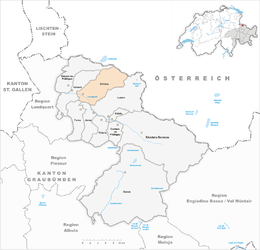Schiers
| Schiers | ||
|---|---|---|
 |
||
|
||
| Coordinates: 46°58′N 9°41′E / 46.967°N 9.683°ECoordinates: 46°58′N 9°41′E / 46.967°N 9.683°E | ||
| Country | Switzerland | |
| Canton | Graubünden | |
| District | Prättigau/Davos | |
| Government | ||
| • Mayor | Mathis-Müller Joos | |
| Area | ||
| • Total | 61.68 km2 (23.81 sq mi) | |
| Elevation | 660 m (2,170 ft) | |
| Population (Dec 2015) | ||
| • Total | 2,643 | |
| • Density | 43/km2 (110/sq mi) | |
| Postal code | 7220 | |
| SFOS number | 3962 | |
| Surrounded by | Fanas, Furna, Grüsch, Jenaz, Luzein, Sankt Antönien, Seewis im Prättigau, Tschagguns (AT-8), Vandans (AT-8) | |
| Website |
www SFSO statistics |
|
Schiers is a municipality in the district of Prättigau/Davos in the Swiss canton of Graubünden. The first concrete girder bridge ever built, Salginatobel Bridge, is located in Schiers. Designed by Robert Maillart and completed in 1930, in 1991 it was the first bridge to be designated an International Historic Civil Engineering Landmark by the American Society of Civil Engineers.
Schiers is first mentioned in 1101 A.D. as Scieres.
Schiers has an area, as of 2006[update], of 61.8 km2 (23.9 sq mi). Of this area, 36.5% is used for agricultural purposes, while 44.3% is forested. Of the rest of the land, 2.1% is settled (buildings or roads) and the remainder (17.1%) is non-productive (rivers, glaciers or mountains).
The municipality is located in the Schiers sub-district of the Prättigau/Davos district on the border with Austria. The highest point is the Drusenfluh at 2,828 m (9,278 ft). It is located in the lower Prättigau valley at the mouth of the Schraubach. It is the center of the middle and outer Prättigau valley. It consists of the linear village of Schiers and the hamlet of Tersier in the valley and the settlements of Lunden, Fajauna-Stels, Maria-Montagna, Pusserein as well as Schuders on the south slope of the valley. In 1875 the hamlet of Sigg left Schiers for the municipality of Valzeina.
Schiers has a population (as of 31 December 2015) of 2,643. As of 2008[update], 12.0% of the population was made up of foreign nationals. Over the last 10 years the population has grown at a rate of 3.2%. Most of the population (as of 2000[update]) speaks German (89.6%), with Serbo-Croatian being second most common ( 2.1%) and Italian being third ( 1.6%).
...
Wikipedia



